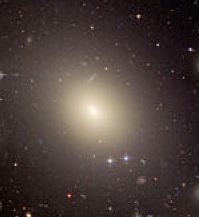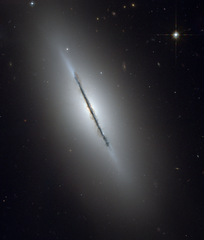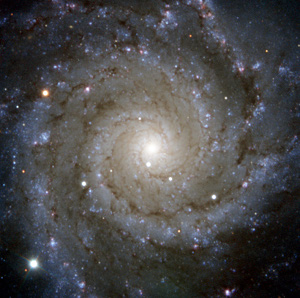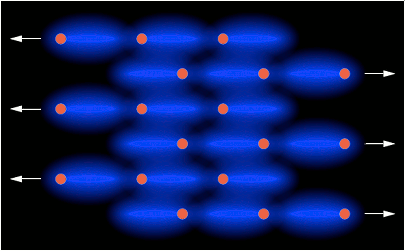© Charles Chandler
- They have elliptical forms.
- The galactic boundaries are indistinct.
- They are comprised mainly of old stars.
- There is very little interstellar plasma.
- The consistency of rotation varies with the aspect ratio.
For these reasons, many scientists consider lenticulars to be related to ellipticals, just with higher aspect ratios. The main difference is that lenticulars have a distinct disc made of dust. This makes them similar to spiral galaxies, except that the dust in a lenticular is not organized into discrete lanes.Spirals (such as our own Milky Way, and NGC 4565 in Figure 5) typically have a central, elliptical bulge, which has many properties in common with elliptical galaxies (i.e., old stars on semi-random orbits around the center, and without much interstellar plasma). The distinguishing characteristics of spirals are that almost all of the stars outside of the central bulge are on the plane of rotation, and when viewed perpendicular to that plane (as in Figure 6), we see that they are organized into spiral arms, dominated by young blue stars, especially on the leading edge of the arms.Interestingly, these galactic forms are evolving. A recent study revealed that in the early Universe, there were far more peculiar galaxies, and now, there are far more spirals.2 (See Figure 9.) This means that peculiars are evolving into spirals. The number of ellipticals & lenticulars has remained relatively constant. If a peculiar first morphs into an elliptical, then a lenticular, and finally a spiral, it's a process that runs at a regular rate, such that the total numbers of galaxies passing through these intermediary stages stay the same over time.
1. Hubble, E. P. (1936): The Realm of the Nebulae. New York: Dover Publications ⇧
2. Delgado-Serrano, R. et al. (2010): How was the Hubble sequence 6 Gyr ago? Astronomy and Astrophysics, 509 (A78): 1-11 ⇧
3. Toft, S. et al. (2014): Sub-millimeter galaxies as progenitors of compact quiescent galaxies. arXiv.org, astro-ph: 1401.1510 ⇧
4. Barnes, J. E. (1989): Evolution of compact groups and the formation of elliptical galaxies. Nature, 338 (6211): 123-126 ⇧
5. Keel, B. (2016): High-redshift radio galaxies in the early Universe. ⇧
6. Trujillo, I.; Carretero, C.; Patiri, S. G. (2006): Detection of the effect of cosmological large-scale structure on the orientation of galaxies. arxiv, L111-L114 ⇧
7. Lin, C. C.; Shu, F. H. (1964): On the Spiral Structure of Disk Galaxies. The Astrophysical Journal, 140: 646 ⇧
























